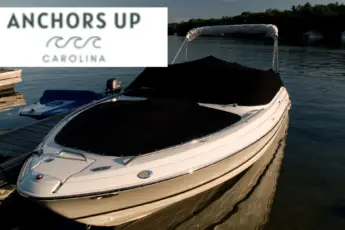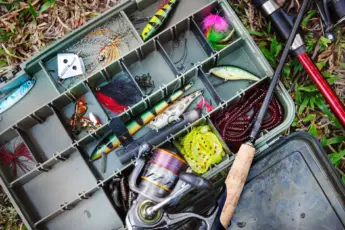When it comes to fishing in Georgia, South Carolina, and North Carolina, the three most popular methods include drift fishing, fishing at anchor, or trolling. However, drifting for fish and anchoring when fishing offers similar approaches to catching fish but are also substantially different. Drift or anchor in both fresh and saltwater. Understanding the differences between anchoring to catch fish and drifting is essential. Here are the differences between the two.
What Is Drift Fishing
When drifting, the vessel moves in the direction the wind or current pushes the boat. The watercraft is not secured in place utilizing an anchor.
Drifting to catch fish is common in both inshore and offshore waters. Baits are presented, ranging between the surface and the seafloor below. Heavy weights are required to hold the bottom due to the constant motion of the vessel. However, a drifting anchor helps slow the drift rate. A drift anchor is similar to a parachute that trails behind the boat just beneath the surface. Using anchors in the drift will allow you to reduce the amount of lead required to hold bait on the bottom.
Regarding how to drift fish, boats typically drift over structures, including rocks, reefs, wrecks, sea mounds, or other areas besides flat bottoms where fish seek shelter. Local agencies sink structures as an anchor with fish because it provides shelter for tiny hatchlings.
What Is Anchor Fishing
Anchor fishing is nearly identical to drifting except for the boat constantly moving. Fishing vessels deploy an anchor from the watercraft’s bow to prevent it from drifting but rather hold its position and swing within a defined arc.
Due to the boat holding its position, lighter weights aid anglers in holding and reaching the bottom compared to drift fishing.
Similar to drifting anglers at anchor also focus their attention on the seafloor with structures where fish are prevalent. The most common of the fishing anchors are grappling hooks which are designed to hold on reefs. Additionally, when anchor fishing the grappling hooks are designed to pull free from the structure with ease when its time to pack up and go home. a Sea anchor for offshore fishing is priced similarly to danforth and other anchor types meant for soft bottoms.
Can You Drift Fish In Georgia, South Carolina, and North Carolina
Yes, anglers in Georgia, South Carolina, and North Carolina drift fish from boats and other watercraft, including kayaks. Drift fishing is done in inshore, over offshore wrecks, offshore blue water, lakes, and rivers.
Remember to never leave anchor for fishing behind despite planning to spend the day drifting. First, conditions may make anchoring the better option. Second, in the event of engine failure, anchors prevent the boat from drifting out to sea or into dangerous waters.
Can You Anchor Fish In Georgia, South Carolina, and North Carolina
Similar to drifting, anglers in Georgia, South Carolina, and North Carolina anchor in fresh and salt bodies of water.
Like drifting, fishing vessels anchor in coastal waters, rivers, lakes, and offshore, targeting multiple species.
What Kind Of Saltwater Fish Can You Catch Inshore At Anchor Or Drifting
A wide range of freshwater and saltwater fish are caught inshore while at anchor or drifting fishing. Here are the most common catches.
Inshore Drifting Or Anchoring
When drifting or anchoring inshore, the most common catches in Georgia, South Carolina, and North Carolina include redfish, sea trout, weakfish, flounder, shark, whiting, etc.
What Kind Of Fish Can You Catch Offshore At Anchor Or Drifting
There is a difference between blue water drifting and reef drifting/anchoring when fishing offshore. Anglers target different species of fish when selecting one location versus the other.
Offshore Drifting Or Anchoring
The type of species caught is highly dependent on the depth in which the bait is presented. Anglers fish all levels of the water column offshore when fishing by drifting or anchoring.
The catches include kingfish, cobia, and amberjack at the surface and middle of the water column.
Anglers reach the bottom with heavy weights and drag snapper, grouper, sheepshead, red drum, and sharks to the surface.
Blue Water Drifting
In the open blue water of the Atlantic Ocean, anchoring is not an option due to the depths. Instead, anglers chum the water with live baits and cast to schooling fish, including mahi-mahi and tuna.
What Kind Of Fish Can You Catch In Freshwater At Anchor Or Drifting
Anglers catch a multitude of fish anchoring and drifting in freshwater rivers, lakes, and reservoirs.
When drifting or anchoring in the fresh bodies of water through North Carolina, South Carolina, and Georgia, anglers catch variations of bass, trout, walleye, perch, catfish, and more. Again it is essential to find structure along the bottom where fish gather in schools.
So Now You Know The Difference Between Drift Fishing And Anchor Fishing
Anglers primarily catch the same fish when drifting or anchoring in inshore, offshore, fresh bodies of water. The only significant difference between drift fishing versus fishing at anchor is holding the vessel in one position as compared to moving with the wind and current. We found success catching fish using both methods. Determining which is better than the other is determined by multiple factors including weather, what fish are biting, a personal preference.







